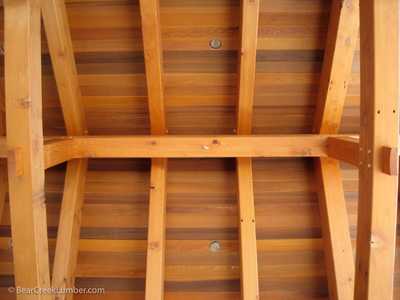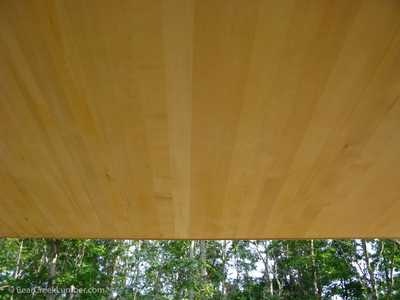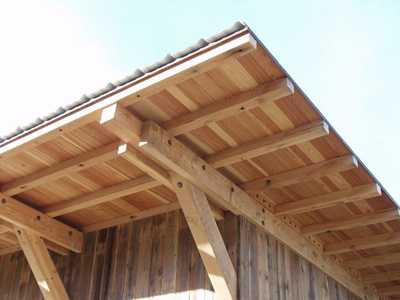
Exterior Soffits
You might be surprised to know how important natural wood exterior soffits are to your home, business, or rental property!
Basically, they serve both an aesthetic and functional purpose for a building’s roofing system. The bonus part is that they can also help to keep your utility bills in check. Especially if you use a cedar product such as red cedar, which has great insulation value.
Bear Creek Lumber sells exterior soffits products in many species of lumber and can offer any size and/or grade you may need. Western Red Cedar, Alaskan Yellow Cedar, Port Orford Cedar, Douglas Fir, Hemlock, Ponderosa Pine and Redwood are the most commonly used species of wood.
Softwood Lumber
Western Red Cedar

Western red cedar soffits are beautiful to look at, provide great insulation value, and will last for a very long time. Visit our Red Cedar pages and take a peek at the perfect compliment to your Bevel, channel or board and batt siding.
This cedar has wonderful insulation qualities and can help to save you money on your utility bills. People will notice the strength, beauty, and ease of use to install. The colors are warm and rich and will maintain their look quite well.Alaskan Yellow Cedar

Alaskan Yellow Cedar is the choice material for lakeside homes, riverfront boathouses and island getaways. The moisture and rot resistance of this wood makes ideal for these locations.
This species of lumber machines well, has a dense and straight grain, and has a pleasing yellowish honey color that is quite beautiful to look at. It will hold up quite well in soffit applications.Douglas Fir

Douglas Fir can add an extra detail of "woodness" to your project, look at these examples and decide for yourself.
It can withstand changes in temperature and humidity, which means it won't warp or swell like other materials. Additionally, Douglas fir is easy to work with and accepts a variety of finishes. These characteristics make it an ideal choice for use in exterior soffit applications.How Exterior Soffits Elevate Building Value and Appeal
Exterior soffits play a crucial role in the construction of buildings, providing both functional and aesthetic advantages that contribute to the overall value of a property. These often-overlooked architectural elements are installed beneath the eaves or roof overhangs and serve as a protective and visually appealing feature. By understanding the multitude of benefits that exterior soffits offer, it becomes evident why they are considered an indispensable part of building design and construction.
One of the primary advantages of exterior soffits is their ability to enhance the visual appeal and overall aesthetics of a building. Soffits provide a finished and polished appearance to the exterior, creating a clean and cohesive look by concealing unsightly elements such as exposed rafters, wiring, and ventilation systems. With a wide range of design options available, including various materials, colors, and textures, soffits can be customized to complement the architectural style and individual preferences, ultimately adding to the curb appeal and aesthetic charm of the building.
Beyond their visual contribution, soffits offer practical benefits that greatly enhance the functionality and value of a building. One of the key advantages is the protection they provide against the elements. By covering the underside of roof overhangs or eaves, soffits act as a barrier, shielding the roof and the building’s interior from rain, wind, and harsh sunlight. This protection helps prevent water infiltration, reducing the risk of moisture damage, mold growth, and the potential deterioration of the underlying structure. Additionally, soffits can offer insulation benefits, contributing to improved energy efficiency by reducing heat gain in the summer and heat loss in the winter, ultimately resulting in cost savings on heating and cooling expenses.
Soffits also play a critical role in promoting proper ventilation within the building. Many soffit designs incorporate vents or perforated panels that allow for the exchange of air in the attic or roof space. Adequate ventilation is essential for preventing the buildup of excess heat and moisture, which can lead to issues such as condensation, mold growth, and damage to the roof structure. Proper airflow facilitated by soffits helps maintain a healthy and well-regulated environment, increasing the longevity of the building and minimizing the need for costly repairs.
Additionally, exterior soffits offer protection against pests and unwanted intrusions. Soffits with integrated screens or mesh act as a physical barrier, preventing insects, birds, and other pests from accessing the building’s interior through the eaves or roof overhangs. This not only safeguards the structural integrity but also enhances the comfort and hygiene of the occupants, providing peace of mind and reducing the risk of infestations or damages caused by pests.
By incorporating exterior soffits in building construction, the overall durability and lifespan of the structure are significantly improved. Soffits act as an additional layer of protection, shielding the roof and eaves from direct exposure to the elements. This added protection helps mitigate the effects of weathering, such as UV radiation, wind, and moisture, which can lead to premature deterioration and structural issues. By ensuring the long-term integrity of the building, soffits contribute to its overall value and reduce maintenance and repair costs over time.
Exterior soffits are indispensable components of building construction, offering a wide range of benefits that enhance the value, functionality, and aesthetics of a property. Their ability to provide protection against the elements, promote proper ventilation, deter pests, and contribute to energy efficiency underscores their significance in creating durable, comfortable, and visually appealing buildings. By recognizing the importance of exterior soffits, builders and property owners can make informed decisions that result in a more valuable and resilient structure.

